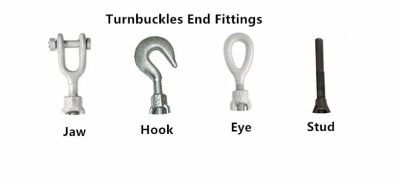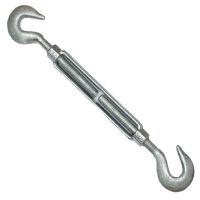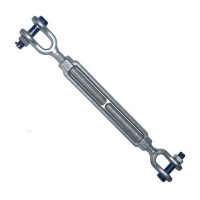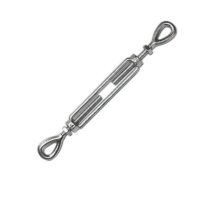If you're involved in construction, rigging, or any industry that requires tensioning and securing heavy loads, then turnbuckle hardware is an essential tool for you. Turnbuckles are versatile devices used to adjust the tension and length of cables, ropes, or rods. They consist of a body with threaded ends and two eyelets or hooks for attaching to the load. In this comprehensive guide, Turnbuckle Hardware supplier'll explore everything you need to know about turnbuckle hardware.
A turnbuckle also is known as rigging screw, tensioner, straining screw, barrel strainer, or adjuster, is a device for adding or releasing the tension or length of ropes, cables, tie rods, and other tensioning systems. They are used for rigging or tensioning wires, ropes, rods, etc., typically within industries such as oil and gas, construction, shipping, mining, and fishing. You can easily twist the turnbuckle body to expand or contract the length, without rotating the end fittings on both sides.
The body of a turnbuckle is the central component that connects the end fittings. It is usually a cylindrical or hexagonal metal bar with internal threads. The body's length determines the maximum extension or contraction of the turnbuckle.
The end fittings of a turnbuckle are the components attached to the cables, ropes, or rods. They come in various shapes, such as jaws, eyes, or hooks, and provide the means for secure attachment and adjustment.
The threads on the turnbuckle body allow for easy rotation and adjustment. They can be right-handed or left-handed, depending on the specific application and requirements.
The most common turnbuckle materials are carbon steel and stainless steel. We usually add a zinc layer on the carbon steel galvanized turnbuckles with protection against rust and corrosion, while stainless steel turnbuckles can be used in high chloride or high moisture environments, as they offer a higher level of corrosion protection. If corrosion is a concern, stainless steel turnbuckle is your best choice.
Rigging turnbuckles are available in many different types, sizes, but basically there are three primary turnbuckle accessories: a turnbuckle body, a right-hand threaded end fitting, and a left-hand threaded end fitting.
There are two main types of turnbuckle body, closed body turnbuckle, and open body turnbuckle, please refer to the following items.

The turnbuckle end fittings work in conjunction with other anchor points to adjust the tension of the cable or rope by turning the turnbuckle body. There are essentially four main types of end fittings commonly used with turnbuckles, which include:
Hook end – are used for temporary connections and are much easier to install and attached or detached from other rigging components than jaw end turnbuckle and eye to eye turnbuckle. However, it is far less practical due to the lack of a safety latch, which may unexpectedly release from attached rigging components, cause the hook to dislodge.

Jaw end – are composed of a jaw, bolt, and nut, but depending on size, some jaw turnbuckles only come with a cotter and a pin. They can attach the wire rope sling straight onto the jaw end and pin to the lifting eye bolts and lugs, which cannot be opened.

Eye end – are intended for straight-line pulls only or in-line applications not for lifting purposes. They have no moving and opening parts, designed for a shackle or quick link to go through on each eye end, then attached a wire rope sling or other approved rigging components.

The two ends of the turnbuckle can be combined according to different needs, whether the solution is permanent or temporary, so there are many types of turnbuckles.
Jaw & jaw turnbuckles have a jaw-shaped end fitting on both ends, which provides a secure grip on the attached cables or rods. These turnbuckles are commonly used in applications where high tension and heavy loads are involved, such as construction and rigging.
Eye & eye turnbuckles have an eyelet end fitting on both ends, allowing for easy attachment of cables, ropes, or rods using shackles or other connecting hardware. They are widely used in various industries, including marine, sports, and architectural applications.
Hook & eye turnbuckles have a hook-shaped end fitting on one end and an eyelet end fitting on the other end. This configuration allows for flexible attachment options, making them suitable for applications where one end needs to be secured to a fixed point, while the other end requires adjustability.
Hook & hook turnbuckles feature a hook-shaped end fitting on both ends, providing a versatile attachment solution for cables, ropes, or rods. They are commonly used in temporary structures, outdoor activities, and other applications that require easy and quick setup.
To ensure the safe and effective use of turnbuckles, follow these installation guidelines or chick here for more about Use A Turnbuckle.
Before installation, thoroughly inspect the turnbuckle for any signs of damage or wear. Replace any defective or worn-out components to prevent failures during operation.
Attach the load to the turnbuckle's end fittings using appropriate connectors, such as shackles or hooks. Ensure a secure connection to prevent accidental disengagement.
Rotate the turnbuckle body clockwise or counterclockwise to adjust the tension of the cables, ropes, or rods. Use appropriate tools, such as wrenches or spanners, for better control and accuracy.
Periodically inspect the turnbuckle and its components for signs of wear, corrosion, or deformation. Lubricate the threads and moving parts as needed to maintain smooth operation and prevent seizing.
When working with turnbuckles, it's crucial to prioritize safety. Consider the following:
Never exceed the maximum load capacity of a turnbuckle. Overloading can lead to catastrophic failures and accidents. Always refer to load capacity charts and guidelines provided by the manufacturer.
Perform regular inspections of turnbuckles to identify any signs of wear, corrosion, or damage. Replace faulty components immediately and avoid using compromised turnbuckles.
Store turnbuckles in a dry and well-ventilated area to prevent corrosion. Keep them away from corrosive substances and extreme temperatures that can affect their integrity.
Turnbuckle hardware plays a vital role in various industries, providing adjustable tensioning solutions for cables, ropes, and rods. Understanding the different types, components, and proper usage of turnbuckles is essential for ensuring safety and efficiency in your projects. By following the guidelines outlined in this guide, you can confidently select, install, and utilize turnbuckles for your specific applications.
As a leading manufacturer of high-quality power transmission and distribution products, Yipeng ensures superior craftsmanship and reliable performance in every product. Our turnbuckle hardware, rigorously tested and trusted by clients worldwide, is designed to meet the demands of both domestic and international markets.
With over a decade of expertise, cutting-edge technology, and a commitment to customer satisfaction, we guarantee products that not only meet but exceed industry standards. Contact us today to learn how Yipeng can power your projects with durable, precision-engineered fittings.
Related Information
+86 319 878 9350
+86 156 1304 7999
+86 319 878 9350
NanYan, DongHuan Road, Shahe, Hebei China
Copyright © Hebei Yipeng Line Equipment Co., Ltd. All Rights Reserved. | Sitemap Powered By 
